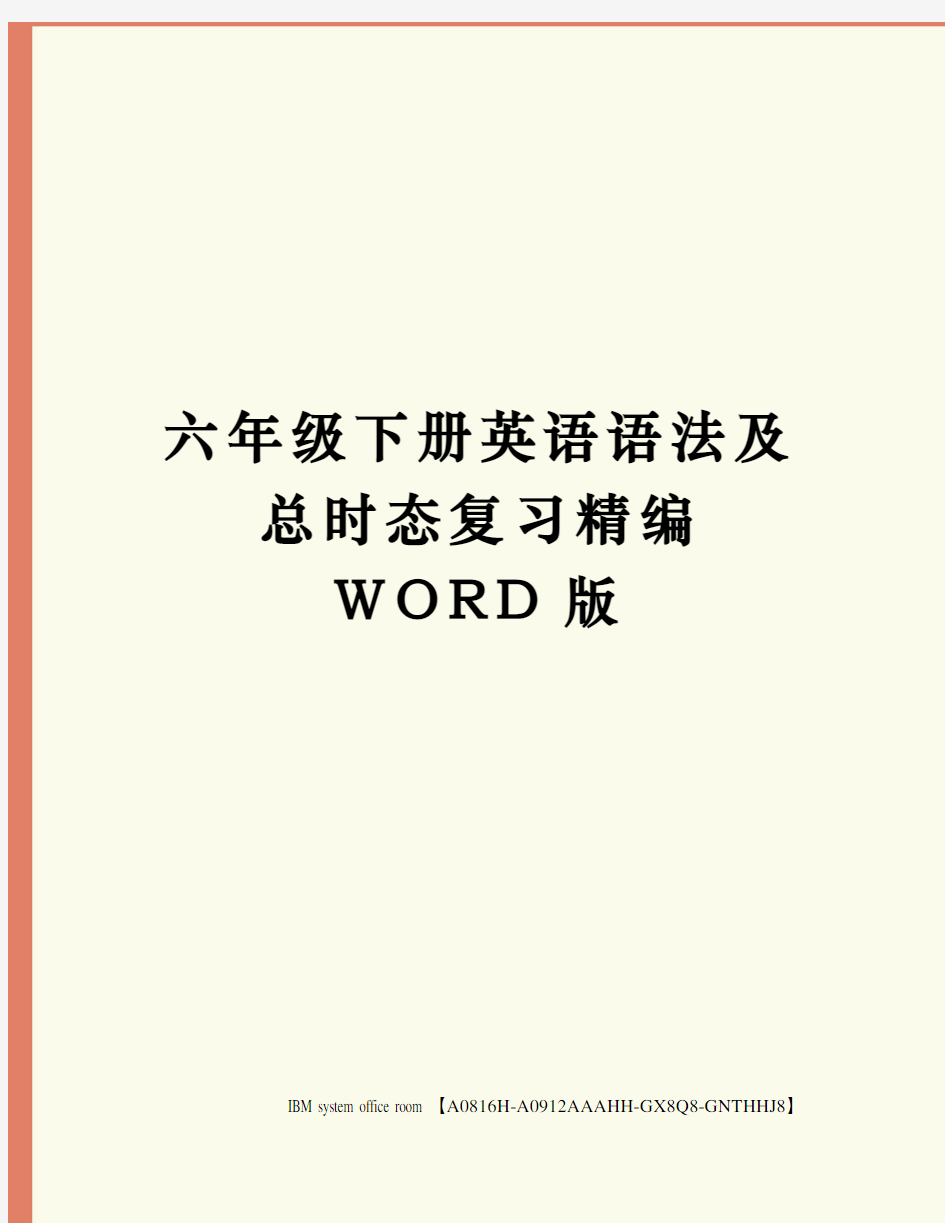六年级下册英语语法及总时态复习定稿版


六年级下册英语语法及总时态复习精编
W O R D版
IBM system office room 【A0816H-A0912AAAHH-GX8Q8-GNTHHJ8】
六下第一单元语法:
形容词比较级的变化规则
1. 直接加er
Strong er small er
2.后三位:辅元辅,双写,再加er
big ger fat ter thin ner hot ter
3.“辅音+y结尾”:词尾的y变成i,再加er
heav ier happ ier funn ier
4. 以不发音的e结尾的,直接加r
nicer cuter
5.特殊 good/ well --better
句型:A is +比较级than B.
六下第二/三单元语法:一般过去时
一、动词的规则变化(不规则变化参照书69页)
1.直接加ed:work—— worked look——looked
2.以不发音e结尾的单词,直接加d:live ——lived hope——hoped use——used 3.以辅音字母+y结尾i的,变y为i加ed:
study—— studied cry- cried worry——worried
4.辅-元-辅结尾:双写最后的辅音字母+ed:stop—— stopped plan——planned
二、句法结构
1、肯定形式
主语+动词过去式+其他 She went shopping last night..
2、否定形式
①was/were+not;②在动词前加didn't,同时动词变回原形
例句: He wasn’t at home. I didn't know you like coffee.
3、一般疑问句
①Did+主语+动词原型+其他②Was/Were+主语+其他
例句:Did I do homework? Was he a student
六下第四单元语法:前后对比
1.某地有某物的表达(现在时)
There is a/an + 单数名词/ 不可数名词( water . milk . rice ) +其他
There are +复数名词+其他
否定结构:在is / are 后面加not There isn’t / There aren’t.....
2.某地有某物的表达(过去时)
There was a/an .....
There were....
3.某地没有某物的表达(过去时)
There was no+ 单数名词
There were no + 复数名词
4.Before, .....(过去时造句). Now, ......(现在时造句)
以前怎样,现在怎样
时态复习
一般现在时
一、一般现在时的功能
1.表示经常性或习惯性的动作,常与表示频度的时间状语连用。
如:
always, usually, often, sometimes, seldom(很少)
never(决不)every day, at 8:30, on Sunday, in the morning等。
如:I always get up at 6:00 in the morning.
2.表示现在时刻的状态、能力、性格、个性。
如:She loves English very much.
My sister p lays the piano very well.
3.表示客观的事实。
如:The sun rises in the east. 太阳从东方升起。
4.格言或警句。
如:Pride goes before a fall. 骄者必败。
注意:
1.如果句子主语的人称是I, we, you, they或复数名词时,动词用动词原形。
如:We often go home by bus.
2.如果句子的主语是第三人称单数,即:he, she, it 或单数名词时,动词要用第三人称的单数形式。
如:He often go es home by bus. Mary likes?Chinese.
注意:动词的第三人称单数形式的构成规则如下:
1.一般情况下在动词的后面直接加“s”;
如:work→works play→plays rain→rains see→sees visit→visits 2.以o, x,s,sh, ch结尾的动词,在后面加“es”;
如do→does fix→fixes guess→guesses wash→washes teach→teaches watch→watches
3.以辅音字母加y结尾的动词,先把“y” 改为“i”, 再加“es”;
如:fly→fl ies study→stud ies carry→carr ies
4.不规则变化。
如:have→has
二、一般现在时的否定句
存在动词时的否定句
1.如果句子的主语是I, we, you, they或复数名词时,则在主语的后面加don’t。
否定句:主语 + don't + 动词原形 (+其它)
2.如:I like bread. → I don't like bread.
3.We always go to school on foot.→We don’t always go to school on foot.
4.如果句子的主语是he, she, it或单数名词时,则在主语的后面加doesn’t 但是要
把动词第三人称单数形式改为动词原形。
否定句:主语 +doesn’t +动词原形 (+其它)
He often goes to school by bike.
→He doesn’t often go to school by bike.
结构: Do + you/ they / I /we +动词原型
肯定回答:Yes, I /we/ they do.
否定回答: No, I/ we/ they don’t.
如:They go to school by bus every day. →Do they go to school by bus every day?
→Yes, they do.(肯定句)→ No, they don’t.(否定句)
2.如果句子的主语是he, she, it 或单数名词时
(1)用does放句首引导疑问句
(2其余句子的位置不变,但是把动词第三人称单数形式改为动词原形。
结构:Does +主语+动词原形 + 其他?
如:Does he /she / it / his father watch TV on the weekend?
肯定句:Yes, he /she / it does.
否定句: No, he /she / it doesn’t.
特殊疑问句:疑问词 +一般疑问句(对划线部分提问常用)
1. 有be动词的:
2.现在进行时的基本结构为主语+be(am /is /are)+动词ing。
be动词随着主语选择使用is,am或者are。如:I am reading a book.
He is taking a picture.
They are cleaning the room.
3.现在进行时的否定句在be后加not
如:I am not reading a book.
He is not ( isn’t ) taking a picture.
They are not( aren’t ) cleaning the room.
4.现在进行时的一般疑问句把be动词调到句首
如:Are you reading a book Is he / she/ it taking a picture.
Are they cleaning the room
5.现在进行时的特殊疑问句的基本结构为:
疑问词+ be +主语+动词ing?
如: What are you doing?
Where is he going shopping
6.但疑问词当主语时其结构为:疑问词+ be +动词ing?
如:Who is catching butterflies?
Who are having a picnic?
附:动词加ing的变化规则
1.一般情况下,直接加ing,如:cook - cooking play - playing
2.以不发音的e结尾,去e加ing
如:make-making taste-tasting have-having
3.如果末尾是一个元音字母和一个辅音字母双写末尾的辅音字母,再加ing 如:run-running stop- stopping swim-swimming
shop- shopping
一般将来时
一、概念:表示将要发生的动作或存在的状态及打算、计划或准备做某事。
句中一般有以下时间状语:tomorrow, next day(week, month, year…),soon, the day after tomorrow(后天)等。
二、基本结构:① be going to + do;
② will+ do.
三、否定句:
结构:在be动词(am, is, are)后加not 或情态动词will后加not 成 won’t.
例如:I’m going to have a picnic this afternoon.
→ I’m not going to have a picnic this afternoon. = I won’t (will not) have a picnic...
四、一般疑问句:
结构:be或will提到句首,some改为any, and改为or,第一二人称互换。
例如:We are going to go on an outing this weekend.
→Are you going to go on an outing this weekend
五、对划线部分提问。一般情况,一般将来时的对划线部分有三种情况。
1.问人Who?
例如:I’m going to New York soon.→Who’s going to New York soon?
2. 问干什么
What …D o?
例如My father is going to watch a race with me this afternoon.
→What is your father going to do with you this afternoon?
3.问什么时候When?
例如:She’s going to go to bed at nine. →When is she going to bed?
六、同义句:be going to = will
I am going to go swimming tomorrow(明天).
= I will go swimming tomorrow.
